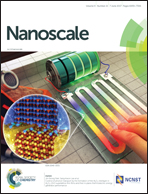Synthesis and fast transfer of monolayer MoS2 on reusable fused silica†
Abstract
Atomically thin, two-dimensional materials ranging from superconductors, metals, semiconductors to insulators are emerging as potential candidates for the next-generation digital electronics and optoelectronic applications. Their synthesis on a commonly used substrate and fast transfer to a plenty of desired substrates need to be addressed to meet the industrialization criteria for practical applications. In this study, fused silica, which is amorphous, transparent, and inexpensive, was examined as a substrate for MoS2 synthesis. The MoS2 growth behavior on fused silica and its crystal quality were evaluated. In addition, a novel way was developed to quickly peel off MoS2 from the fused silica surface within 15 s (i.e., etching in an acidic solution to detach the edge and completing the delamination via a capillary force at the interface between air and water). The fused silica could be reused at least three times. Moreover, the produced MoS2 domains showed no obvious degradation of quality. These results support the feasibility of MoS2 synthesis on amorphous and recyclable substrates and also the time-saving transfer for the cost-effective and high-quality production of other two-dimensional materials.



 Please wait while we load your content...
Please wait while we load your content...